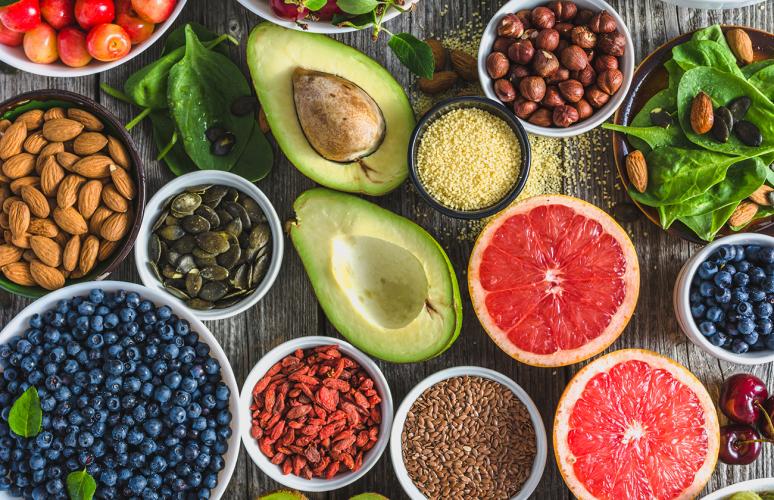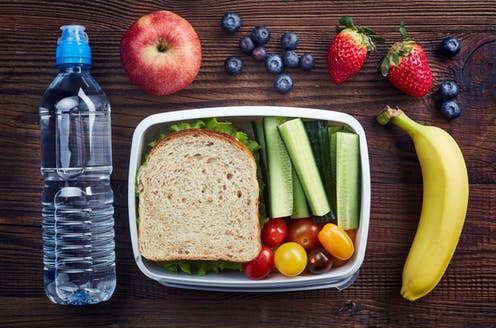During these difficult times, it can be easy to slip into bad habits, and lose sight of our health goals.
However, maintaining your healthy habits during the COVID-19 outbreak is more important than ever. In particular, proper nutrition can play a key role in reducing the severity and duration virus symptoms, minimizing the risk for vulnerable communities (i.e. elderly, those with chronic disease), preventing weight gain from reduced physical activity, boosting productivity at home, and supporting your mental health.
Check out our 5 tips for maintaining your healthy habits at home:
- Establish an eating routine
For those of you who spend most of your time out of the house (at work, running errands etc), your routine may have centered around set meal and snack times. However, with most of us either working from home, on leave or trying to occupy the children, old eating routines may have flown out the window!And, as you may have already experienced, without structure or set eating times it’s easy to fall into bad habits. For example, skipping meals, having larger meals, extra snacking and/or ‘non-hungry’ eating.
To prevent over/under eating and promote healthier food choices, we suggest establishing a new eating routine to match your needs at home. For example:
– Breakfast: 8am
– MT: 11am
– Lunch: 1.30pm
– AT: 4pm
– Dinner: 7pm
– Supper: 8.30pmTake this a step further by planning what you choose to eat, and how much, at each set time. Consider your energy needs – if you are less active at home, you may plan to eat less than usual (i.e. smaller or less frequent snacks)
- Revise your portion sizes
Many of us will admit to having large portion sizes, particularly at dinner. With more time on your hands, now might be an excellent time to revise and practice what a healthy portion size is for you. As a general rule, we advise:– The ‘Healthy Plate Rule’: Fill half of your plate with non-starchy vegetables (i.e. broccoli, zucchini, carrot, salad vegetables), a quarter of your plate with lean protein (i.e. meat, chicken, fish, tofu, egg), and a quarter of your plate with low GI carbohydrate (i.e. potato/sweet potato, basmati rice, wholemeal pasta, quinoa, multigrain breads).
– The ‘hand’ rule: A palm size portion of lean protein, a fist full of low GI carbohydrates, two handfuls of non-starchy vegetables, and a thumb of healthy fats (i.e. avocado, extra virgin olive oil, nuts and seeds)
The Nutrition Code dietitians can help you persoanlise your portion sizes, according to your age, gender, activity levels and body composition goals.
- Try some new healthy recipes
Again, with extra time available to shop and prepare meals, why not try a new recipe or two? In fact, cooking something new can add some diversity and excitement to otherwise ‘groundhog’ days in social isolation. You can also learn valuable skills such as portion sizes and healthy cooking techniques. If you want to change things up, for example, by including more plant-based meals, making your own snacks, or using less bottled sauces, now is the time!We love the following websites and books for sourcing healthy recipes. We also have a large portfolio of recipes that we can tailor specifically to your energy and nutrition needs.
– https://www.healthyfoodguide.com.au/
– https://www.taste.com.au/healthy
– https://www.heartfoundation.org.au/recipes
– The CSIRO Total Wellbeing Diet series (inc Total Wellbeing Diet, Low Carb Diet, Diabetes Diet, Healthy Gut Diet, Protein Plus)
-The Mediterranean Diet Cook Book (by Catherine Itsiopolous)
– Donna Hay Fresh and Light magazine
– The Healthy Food Guide magazine - Include some immune boosting foods
As you know, even the best nutrition cant stop the spread or contraction of infectious diseases such as COVID-19. But, having a strong immune system MAY help to minimize the severity and duration (or at least, this has been proven for other, similar viruses).Deficiencies in the following nutrients may compromise your immune system, so make sure you are eating plenty of:
– Zinc and iron: lean red meat, poultry and seafood, tofu, pumpkin seeds, cashew
– Vitamin C: citrus fruits, berries, leafy green vegetables, legumes
– Folate: green leafy vegetables, wholegrain breads and cereals, legumes, nuts
– Selenium: lean red meat, poultry, seafood, brazil nuts
– Probiotics: yoghurt, kefir, sauerkraut, kimchi, probiotic supplements
– Vitamin D: oily fish, eggs, mushrooms, fortified milk - Manage emotional eating
Many of us will succumb to emotional eating every so often, some more so than others. Emotional eating involves using food to control or suppress emotions, usually such as stress, anxiety, sadness, boredom or loneliness.We anticipate that COVID-19 may cause higher levels of emotional eating, which is understandable, given the large disruption to our daily routine, income and job security, access to support services and ability to connect with loved ones.
However, if left unchecked, emotional eating can wreak havoc on your physical and emotional health. Here are a few useful strategies for overcoming emotional eating.
– Identify, name and address the emotion: Is it stress? Sadness? Boredom? If you can notice your emotions before they have a chance to escalate, you may feel more empowered to intervene. Try writing a list of things you can do, as an alternative to eating, in order to address the emotion. For example, taking a hot bath or shower, or going for a walk.
– Try breathing or meditation exercises: With some extra time on your hands, you may consider adding breathing or meditation exercises to your daily routine, as a way to keep day-to-day stress and anxiety at bay. You can also turn to these exercises when you feel emotions starting to ‘bubble up’.
– Have a contingency plan: If you really MUST eat something, have a list of healthier options ready. For example: sliced apple with 1tsp nut butter, berries with natural yoghurt, roasted chickpeas, or cottage cheese and honey on Ryvita.



